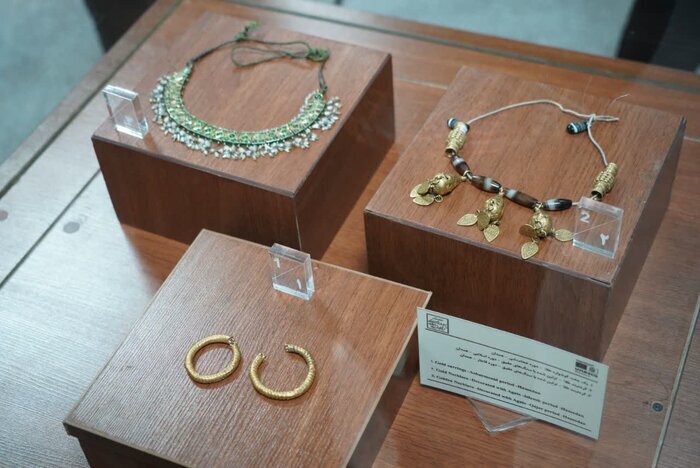Hegmataneh Museum unveils golden artifacts to mark Intl. Museum Day

TEHRAN - In celebration of International Museum Day, the Hegmataneh Museum in Hamedan province has unveiled three exquisite golden artifacts, offering visitors a rare glimpse into Iran’s rich cultural heritage spanning millennia.
The unveiling ceremony, held on Saturday under the global theme “Museums for a Sustainable Future,” was led by the provincial tourism chief Mohsen Masoum-Alizadeh.
The objects comprised a gold earring from the Achaemenid era, a gold bracelet inlaid with agate stones from the (early) Islamic period, and a gold necklace also adorned with agate stones from the Qajar era.
All three pieces were discovered in the Hamedan region and are being publicly exhibited for the first time under the title “gold and time: golden narratives from Iran’s history.”
“These artifacts are not only artistic masterpieces but also powerful historical documents that reflect the deep cultural and historical roots of Hegmataneh,” Masoum-Alizadeh said, emphasizing their role in preserving the identity of this ancient city.
Hegmataneh–also known as Ecbatana–is a UNESCO-registered site and one of Iran’s most storied ancient cities, renowned for its archaeological and cultural significance dating back to the Median Empire.
Masoum-Alizadeh also announced progress on the establishment of the West Iran Regional Museum, which will showcase additional archaeological discoveries from the broader region, further expanding public access to Iran’s historical treasures.
According to the official, the unveiling marked the beginning of Iran’s Cultural Heritage Week, which aims to promote public appreciation for the country’s diverse historical legacy through exhibitions, events, and educational programs.
Located in the suburban area of modern Hamadan, Hegmataneh spans approximately 50 acres, with its rich archaeological deposits offering a glimpse into millennia of human civilization. Despite its vast historical significance, large portions of the site remain unexplored, promising future discoveries that could further illuminate our understanding of ancient Iran.
Hegmataneh is universally celebrated as the site where the Median Dynasty was first established. Serving as the capital of the powerful Median Empire, Hegmataneh later became a significant center for the Achaemenid Empire, one of the most influential empires in history. The city's historical significance is further enriched by its role during subsequent periods, including the Seleucid, Parthian, Sassanid, and Islamic eras. Each era left its indelible mark on Hegmataneh, shaping it into a vibrant tapestry of cultural evolution.
The site is a treasure trove for archaeologists and historians alike. The site houses an impressive array of remains from various dynasties, including the Medes, Achaemenid, Parthian, Sassanid, and Islamic periods, particularly the Buyid dynasty. While the majority of the remains belong to the Parthian era, the site also features urban architectural systems that are considered masterpieces of their time.
AM
Leave a Comment